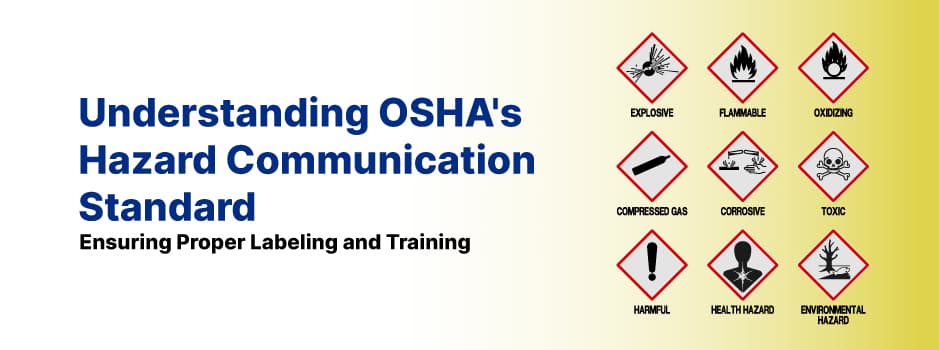OSHA's Hazard Communication Standard (HCS) is designed to ensure that information about chemical hazards in the workplace is properly communicated to employees, enabling them to make informed decisions about their safety. The HCS requires employers to provide appropriate labeling of hazardous chemicals, maintain safety data sheets (SDSs), and offer employee training on hazard communication. In this blog, we will delve into the key aspects of OSHA's HCS, focusing on proper labeling and training, and providing tips on how to maintain compliance with these critical safety requirements.
Overview of OSHA's Hazard Communication Standard
The HCS, found in 29 CFR 1910.1200, is based on the premise that employees have a right to know about the hazardous chemicals they may be exposed to in their workplace. The standard requires employers to establish a comprehensive hazard communication program that includes:
- Proper labeling of hazardous chemicals
- Maintenance of safety data sheets (SDSs)
- Employee training on chemical hazards and protective measures
- A written hazard communication program
By ensuring that employees have access to this vital information, the HCS helps to reduce the incidence of chemical-related injuries and illnesses in the workplace.
Proper Labeling of Hazardous Chemicals
Under the HCS, all hazardous chemicals must be labeled with specific information to ensure that employees can quickly and easily identify the hazards associated with each chemical. OSHA has adopted the Globally Harmonized System of Classification and Labeling of Chemicals (GHS) to standardize labeling requirements, making it easier for employers to comply with the HCS and improving the overall effectiveness of hazard communication.
GHS-compliant labels must include the following elements:
- Product identifier: The name or number used to identify the chemical
- Signal word: A word used to indicate the relative severity of the hazard, such as "Danger" or "Warning"
- Hazard statements: Descriptions of the nature and severity of the hazards posed by the chemical
- Precautionary statements: Instructions for safe handling, storage, and disposal of the chemical, as well as first aid and emergency response measures
- Pictograms: Symbols used to visually convey specific hazard information
- Supplier identification: The name, address, and phone number of the manufacturer, importer, or distributor responsible for the chemical
Employers are responsible for ensuring that all hazardous chemicals in their workplace are properly labeled with GHS-compliant labels and that employees understand how to interpret the information on these labels.
Safety Data Sheets (SDSs)
In addition to proper labeling, the HCS requires employers to maintain safety data sheets (SDSs) for all hazardous chemicals in their workplace. SDSs are detailed documents that provide comprehensive information about the hazards associated with a specific chemical, as well as guidance on safe handling, storage, and disposal procedures.
SDSs must be readily accessible to employees and should be organized in a manner that allows for easy retrieval in the event of an emergency. Employers should also periodically review their SDS inventory to ensure that all required documents are up to date and that any outdated or unnecessary SDSs are removed.
Employee Training on Hazard Communication
A critical component of the HCS is the requirement for employers to provide training to employees on the hazards associated with the chemicals in their workplace and the protective measures they should take to minimize their risk of exposure. Effective hazard communication training should include the following topics:
- An overview of the requirements of the HCS and the employer's hazard communication program
- The methods used to detect the presence of hazardous chemicals in the workplace, such as monitoring devices or visual indicators
- The physical and health hazards associated with the chemicals in the workplace
- Protective measures, including the use of personal protective equipment (PPE), safe work practices, and emergency response procedures
- How to interpret GHS-compliant labels and safety data sheets, and how to use this information to protect themselves from chemical hazards
- The location and accessibility of safety data sheets and the employer's written hazard communication program
Employee training should be provided at the time of initial assignment to a job involving potential exposure to hazardous chemicals and should be repeated whenever a new chemical hazard is introduced into the workplace. Periodic refresher training can also help to reinforce employees' understanding of hazard communication requirements and ensure that they remain vigilant in protecting themselves from chemical hazards.
Maintaining Compliance with OSHA's Hazard Communication Standard
To maintain compliance with the HCS, employers should take the following steps:
- Develop a written hazard communication program that outlines the employer's policies and procedures for complying with the HCS, including proper labeling, SDS maintenance, and employee training
- Regularly review and update the written hazard communication program to ensure that it reflects current workplace conditions and hazard communication requirements
- Conduct periodic audits of the workplace to verify that all hazardous chemicals are properly labeled and that SDSs are up to date and accessible to employees
- Provide ongoing training and support to employees on hazard communication, including refresher training, updates on new chemical hazards, and guidance on interpreting labels and SDSs
- Encourage open communication with employees about chemical hazards and actively involve them in the hazard communication process, fostering a culture of safety and shared responsibility
Conclusion
Understanding and complying with OSHA's Hazard Communication Standard is essential for maintaining a safe work environment and protecting employees from chemical hazards. By ensuring proper labeling of hazardous chemicals, maintaining up-to-date safety data sheets, and providing effective employee training on hazard communication, employers can reduce the risk of chemical-related injuries and illnesses and promote a culture of safety in the workplace.

